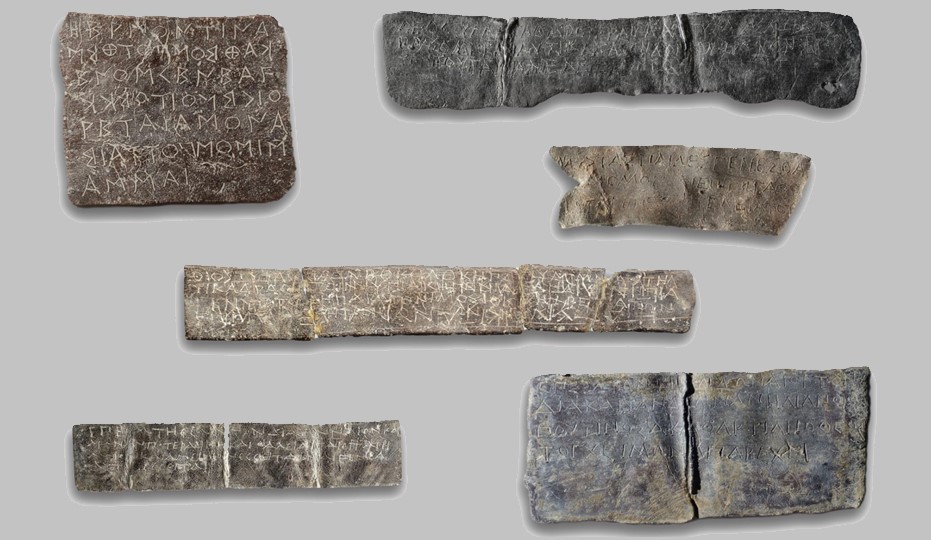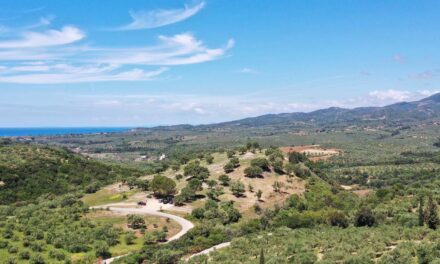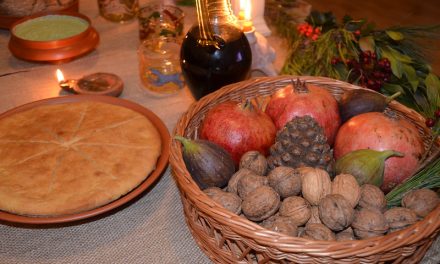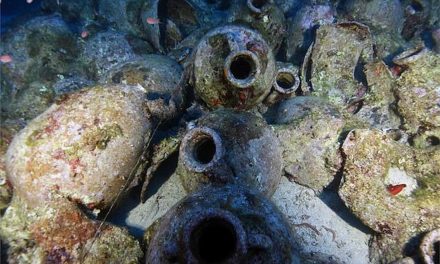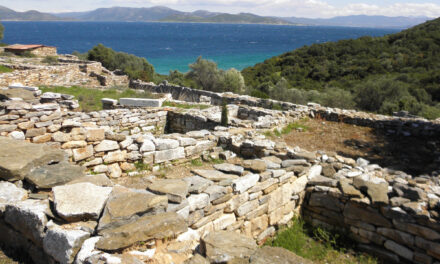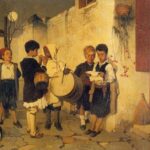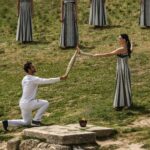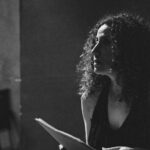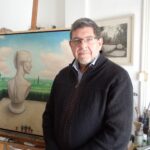The Executive Board of UNESCO, on April 14th, unanimously decided to approve the designation of February 9th as “World Greek Language Day”. The date marks the anniversary of the death of Greece’s national poet, Dionysios Solomos, who passed away in 1857. The official proclamation will take place during the 43rd session of the UNESCO General Conference, in November 2025. The decision of the Executive Board recognizes the universality and the global contribution of the Greek language to the cultural heritage of humanity. It underlines, among other things, the unbroken continuity of 40 centuries of oral tradition and 35 centuries of written tradition of the Greek language, its influence on all other European languages, as well as the fact that it remains to this day an inexhaustible source of international scientific terminology. On this occasion, GNA presents two elements connected to the written Greek language that were inscribed on the UNESCO “Memory of the World” International Register in 2023 and 2015, respectively, “The Lead Tablets of the Dodona Oracle” (Part 1) and “The Derveni Papyrus: The oldest book of Europe” (Part 2).
The lead tablets of Dodona are a unicum in the ancient Greek world dated from the 6th century BC to the mid-2nd century BC, on the basis of script characteristics. They are small pieces of lead strips (measuring not more than ca. 13,20 cm long and 6,70 cm wide), on which questions were inscribed, addressed either only to Zeus or to him and Dione, his cult partner at the Dodona Oracle. In total, more than 4,000 lead tablets have been discovered, scattered within the site of Dodona. Most of the unique authentic tablets of Dodona are kept in the Archaeological Museum of Ioannina.
The pilgrims of the Oracle wrote their question on one side of the lead sheet and then fold or roll it up, enclosing the question inside. Regarding their subject, the questions are divided into public and private. Public questions are relatively few. They are asked by cities or “koina”, and usually concern political or religious matters. Most private questions are usually asked by men, less often by women or couples, and comprise aspects that occupy people at all times and cause them stress, such as family, health, career, travel, property disputes. On the 24th of May 2023, the lead tablets were included to the UNESCO’s list ”Memory of the World” (Source: National Archaeological Museum, archaeology.wiki/blog)
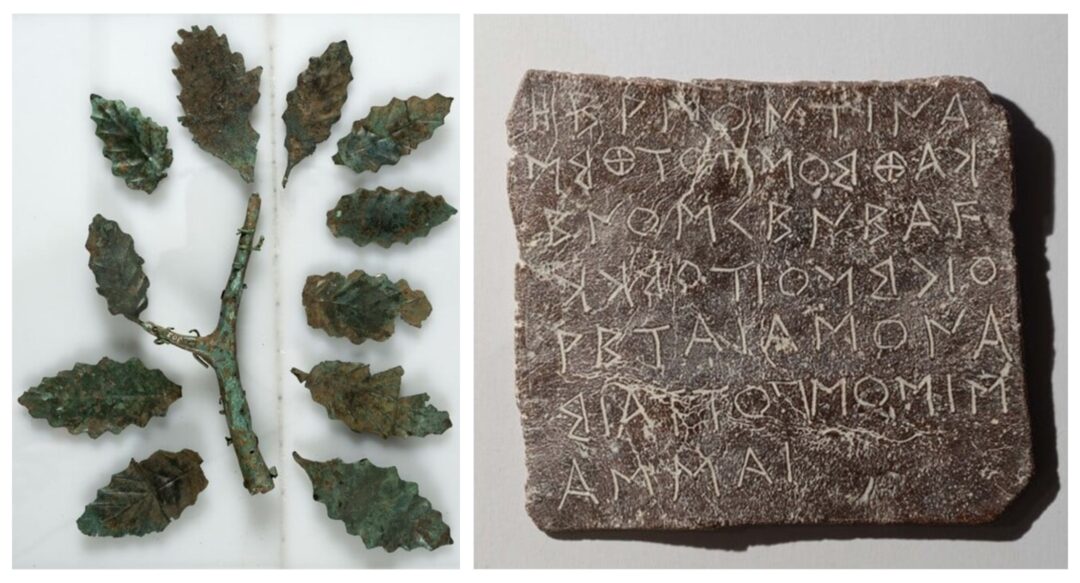
Bronze oak branch with leaves, Dodona, 4th-3rd century BC, National Archaeological Museum (left), Lead tablet from Dodona in Corinthian Boustrophodon script. Hermon asks to which god he should pray to have useful descendants by his wife Kretaia, Archaeological Museum of Ioannina, 525-500 BC (right)
At Dodona, oracular consulting was given through the interpreting of the rustling of oak-leaves, or of the cooing of doves (peleiai), of the flight of birds nesting in the oak trees, as of the murmuring of the waters from the sacred spring or of the clanking of brazen vessels which were hung on the branches of the oak-trees, reminding of modern wind chimes.
The lead tablets give us a direct and unbiased access to the concerns of enquirers. They do not only attest different dialects, but also different handwritings given the multitude of people that visited the oracle over the centuries. Due to the typological variety of the questions and the very diverse origins of the inquirers, the tablets are a set of finds that not only allows a unique insight into the cult practice of the Oracle but also offers instructive information about socio-historical and political contexts and backgrounds, as well as epigraphy and dialectology (Source: UNESCO, Ephorate of Antiquities of Ioannina)
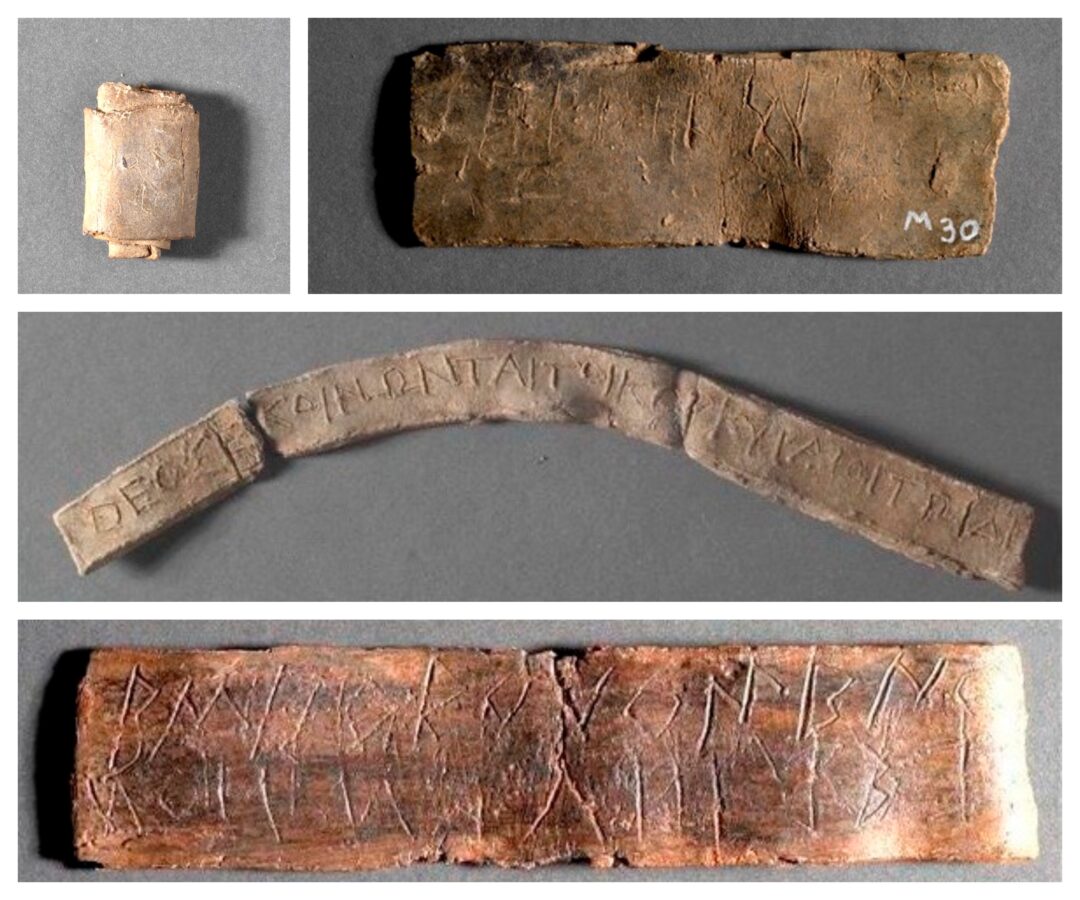
Folded lead tablet (upper left), Lead tablets: M30 (upper right), MI 1724 (middle) and MI 11477 (lower), Archaeological Museum of Ioannina (Source: Ephorate of Antiquities of Ioannina)
The first oracular tablets were found in 1876-77 by archaeologist Konstantinos Karapanos. Many of the tablets that came to light were published by him in Paris, in 1878, in his work “Dodone et ses ruines/Dodona and its ruins”. The bulk of the tablets, which survive today, came to light during the systematic excavations of Dimitrios Evangelides in 1929-1935 and 1952-1959 and were continued after his death by his collaborator Sotiris Dakaris. Dodona Online (DOL) is a project whose purpose is to edit online the oracular tablets (lamellae) from Dodona. (Source: archaeology.wiki/blog)
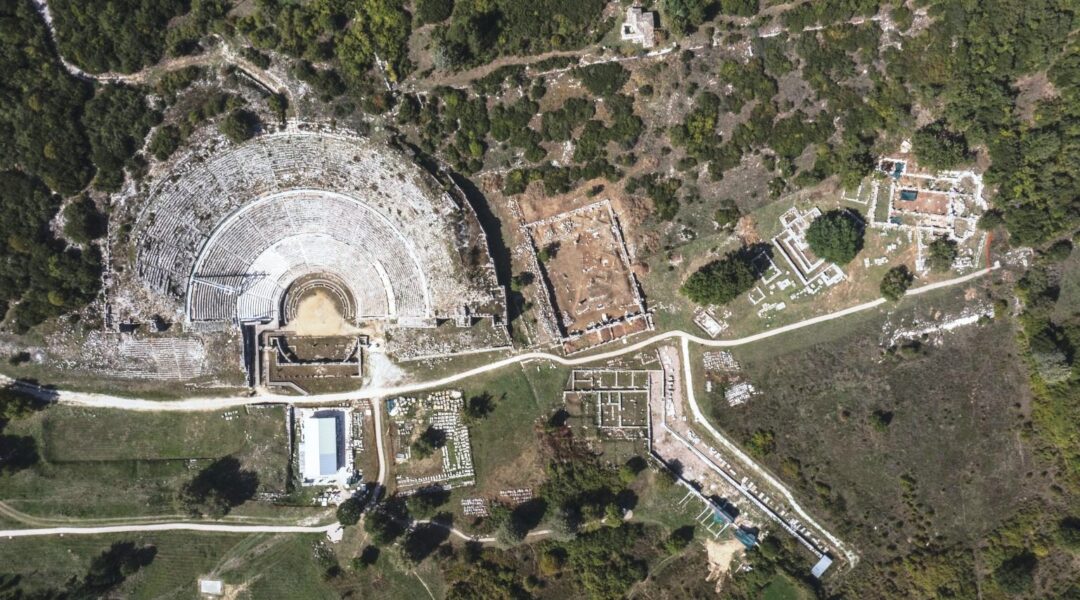
Aerial view of the archaeological site of Dodona (Source: Ephorate of Antiquities of Ioannina)
The oracle shrine (christirion) at Dodona is located in the northwestern part of Greece, in Epirus, 22km south-west of the city of Ioannina. Placed in the narrow valley east of the foothills of Mt Tomaros, 600 meters above sea level, it used to be most easily accessible from the coast of Thesprotia. It was probably the oldest and most prominent Oracle in the early ancient Greek world, dated to the 2nd millennium BC, yet soon it became second to importance after the oracle shrine of Delphi. In the early 3rd century BC, King Pyrrhus made Dodona the religious capital of its domain, adding a number of significant buildings around the oracle such as the temple of Dione. Though quite downgraded from then on, it was active up until the rise of Christianity in 390 AD, when Emperor Theodosius silenced the oracle, closed the temple and cut down its only one surviving oracular oak tree.
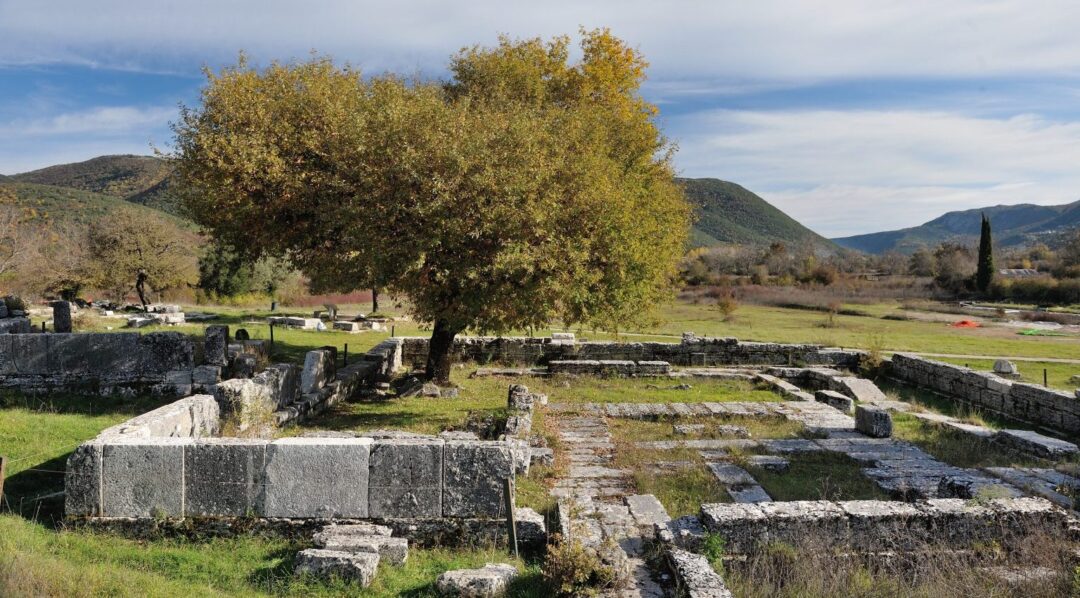
Dodona, the Hiera Oikia (Holly Residence – Temple of Zeus) with the oracular oak-tree had a rectangular structure, measuring 20.80×19.20 m and at least four building phases (Source: odysseus.culture.gr, Ephorate of Antiquities of Ioannina)
The oracle shrine at Dodona was initially dedicated to mother earth (Gaia), who was known as Dione there and later to the couple of Zeus and Dione; in early historic times the sanctuary was an oak tree surrounded by a sacred forest of oak trees with a spring on its foot, sacred to Zeus. Aristotle (Meteorologica) considers the site of Dodona to be the cradle of Hellenes, known as the ancestors of the entire Hellenic race. The Homeric epics inform us that the Oracle was dedicated to Zeus, the lord of Dodona, god of the Pelasgians (i.e. the ancient inhabitants of Greece). According to Homer, Zeus’s priests were barefoot and used to sleep on the ground under the divine oak-tree, and so we can assume that at first there was probably only an outdoors altar in proximity to the oak trees while the temple and the surrounded buildings were constructed in later years (from the 4th century BCE and on).
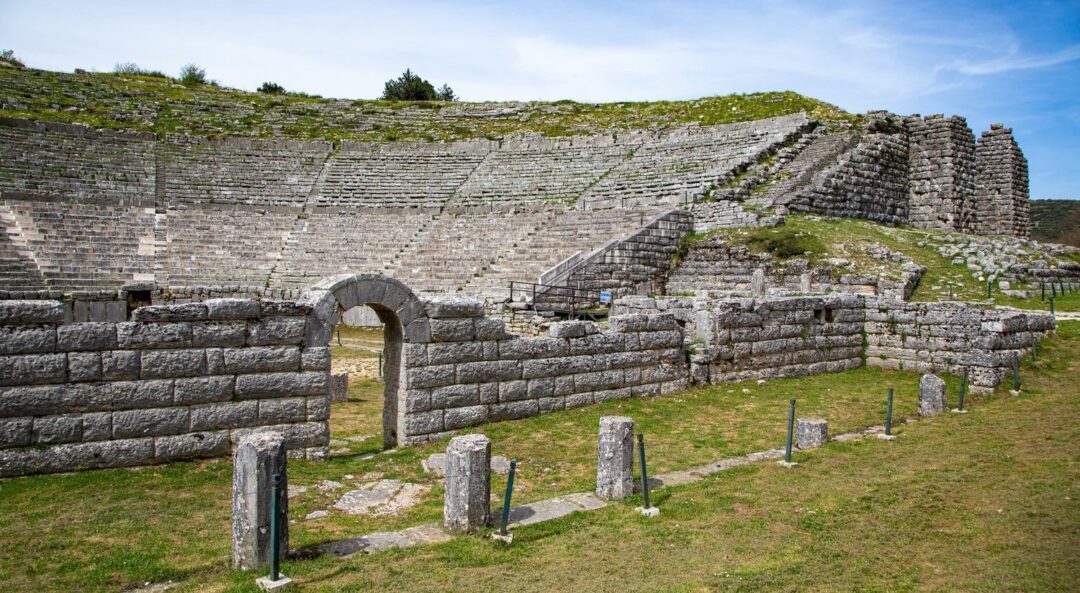
An integral part of the Dodona sanctuary, the ancient theatre of Dodona counts among the largest and best preserved ancient Greek theatres, able to accommodate about 18,000 spectators. It was erected during the period of King Pyrrhus (297-272 BC) (Source: travelioannina.com, odysseus.culture.gr)
Offerings to the divine couple of Zeus and Dione are dated as early as in the 8th century BC. Among them there were jewellery, weapons, statuettes and many bronze tripods and artifacts. (Source: odysseus.culture.gr, visitgreece.gr)
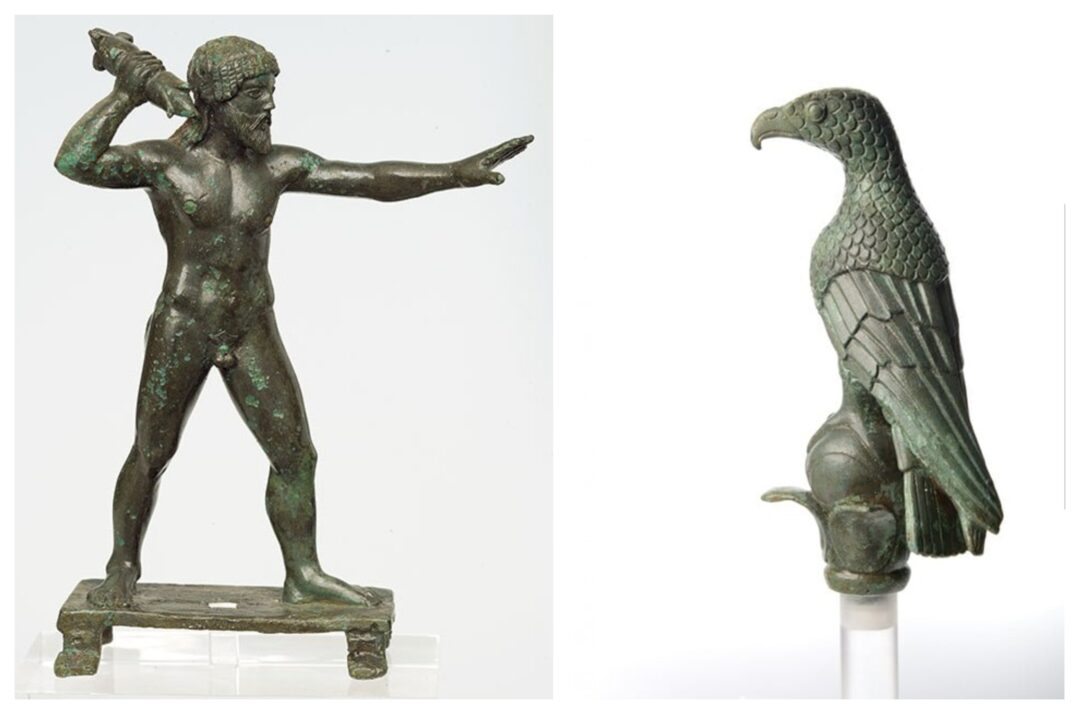
Bronze figurine of Zeus Ceraunaeus from the Sanctuary of Zeus at Dodona, 470-460 BC, National Archaeological Museum. The thunderbolt is a symbol of the presence and authority of the omnipotent god, who seeks to impose the divine order in the world (left), Bronze eagle standing on a lotus blossom, once mounted on the scepter of Zeus, height 10 cm, Dodona, 6th–5th century BC, National Archaeological Museum. According to mythology, Zeus was often depicted with the eagle as a sign of his presence and influence over people and the world. The eagle stands on a lotus blossom, which can be interpreted as a symbol of abundance and divine protection (right).
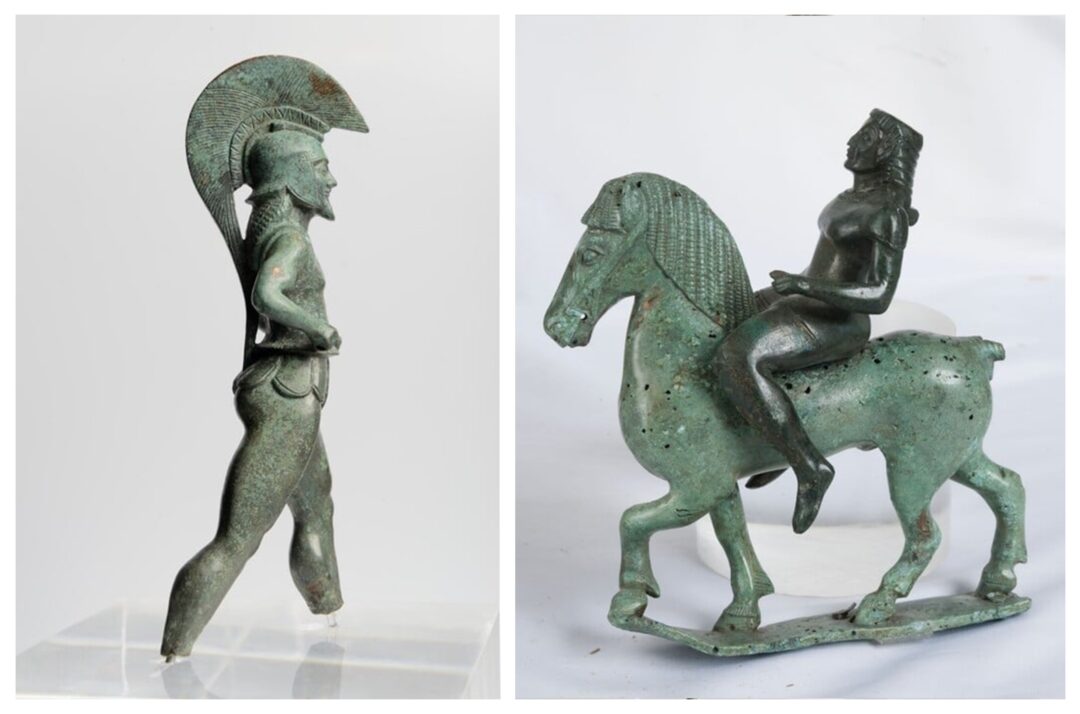
Bronze figurine of a hoplite or hoplitodromos in stride, possibly part of the decoration of a bronze cauldron, 530–510 BC, Dodona, Sanctuary of Zeus and Dione, Archaeological Museum of Ioannina (left), Horseman–Dioskouros from Dodona, ca 570 BC, a work of Corinthian inspiration from a workshop established in northwestern Greece, Athens, National Archaeological Museum, Karapanos Collection (right)
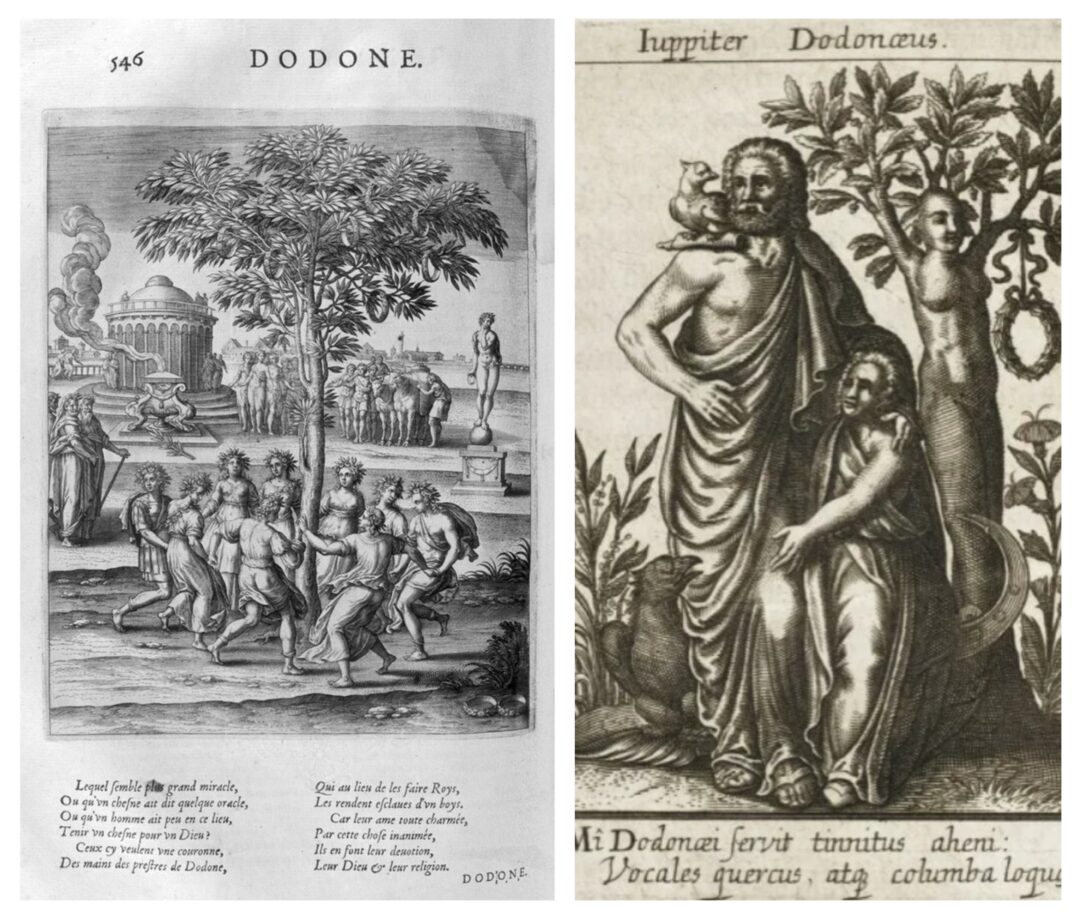
Leonard Gaultier, “Dodona”, 1615 (left), “ Juppiter Dodonaeus”, 1675, Historia Deorum Fatidicorum (right)
The following are some oracular tablets (lamellae) from Dodona displayed in a past Acropolis Museum exhibition, shedding light on people’s questions and timeless human concerns.
Question concerning family issues, household, safety and health:
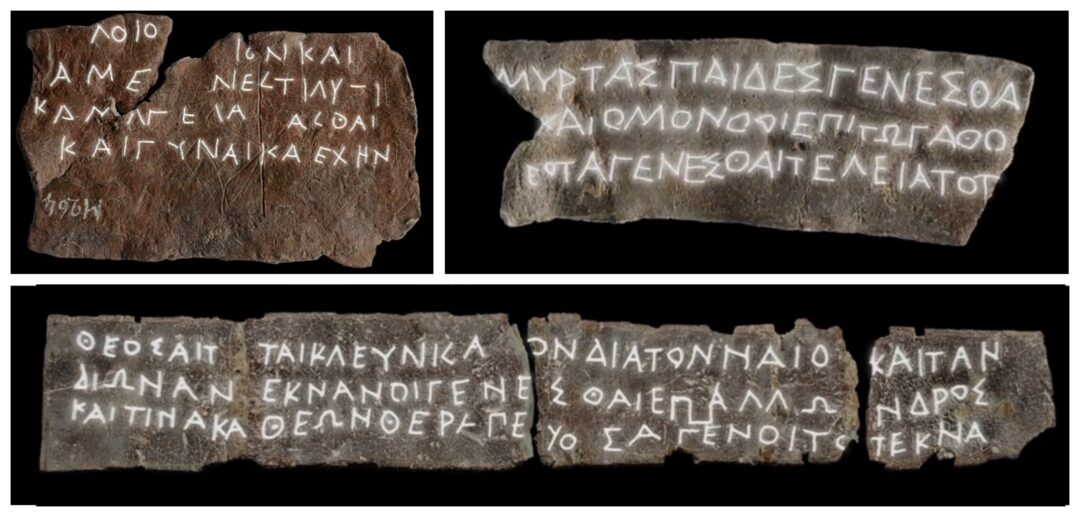
“How can I be relieved of this black magic quickly, before my wife deserts me?” (upper left), “Gods, it’s Myrta speaking to you, that lost her husband and I ask: will my children be united together? Will I remarry?” (upper right), “Zeus Naios and Dione, its Kleoniki asking you: should I go with another man in order to have children? To which Gods should I appeal?” (lower)
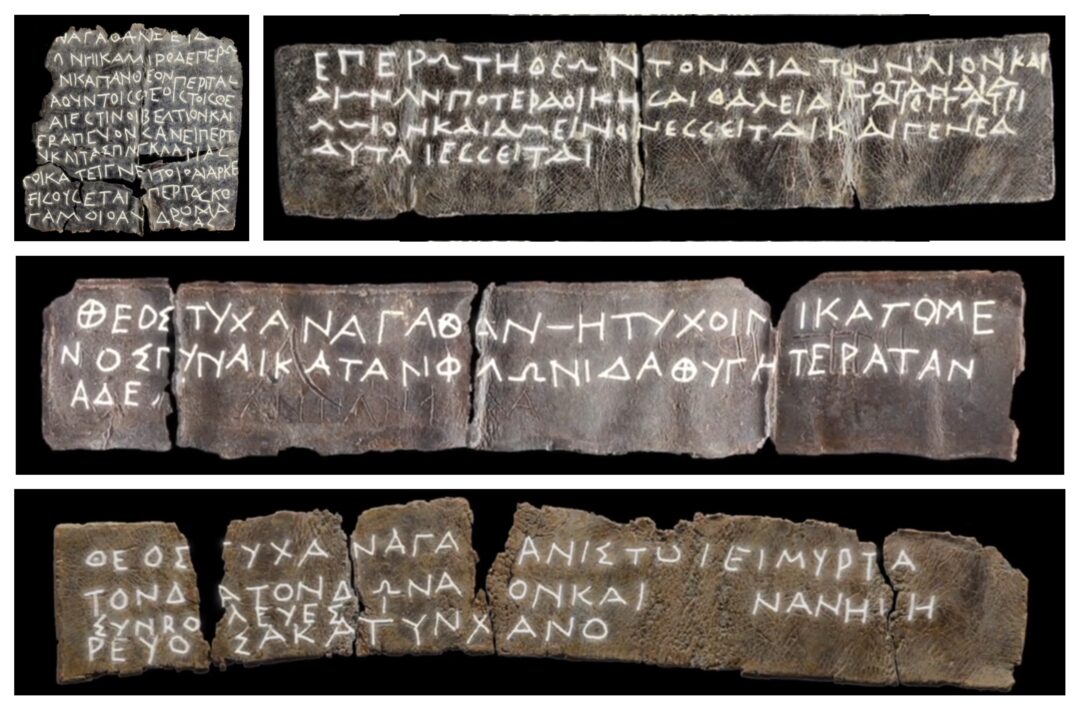
“Zeus Naios and Dione, Theon ask you: when will my daughter Thaleia marry a good man and when will she bear children?” (upper left), “Zeus Dodona and Dione, Kalliroe ask: will my brother and I manage to keep our inheritance so that I can provide a dowry for my daughter Andromache?” (upper right), “Will I be happy if I marry the daughter of Filonedes, the sister of Pamphiles?” (middle), “Zeus Naios and Dione, it’s Myrta speaking to you and I want to know if I will become a widow” (lower)
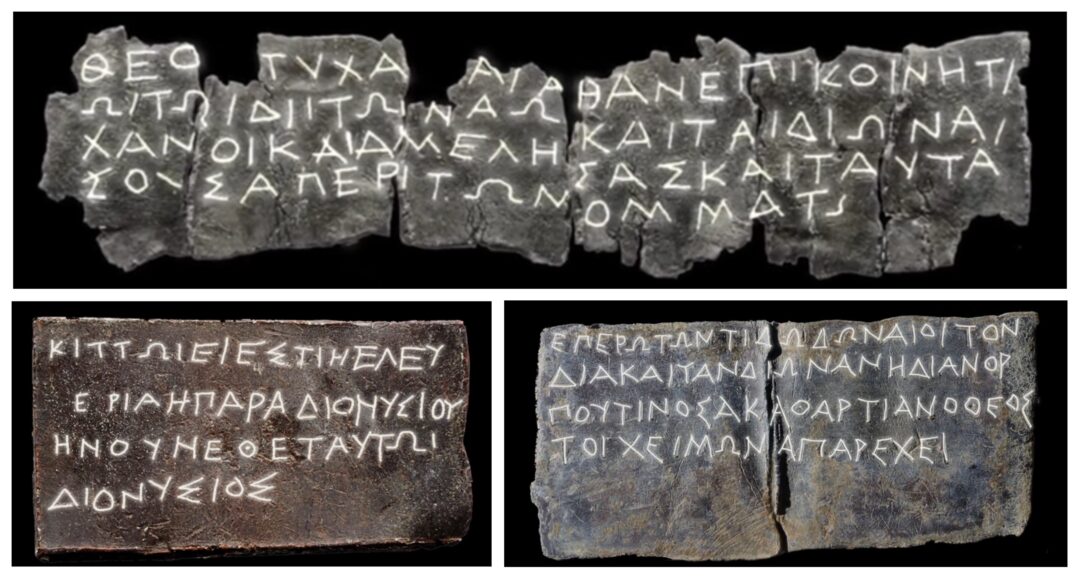
“Zeus Naios and Dione, did my eyes take sick because I neglected you?” (upper), “I am Kittos, slave of Dionysios and I ask: will he set me free as he promised?” (lower left), “Zeus Naios and Dione, is this deep winter caused by a transgression by one among us?” (lower right)
Question concerning financial issues and business:

“What is better for me, to immediately pay my debts or leave it for later?” (left), “Gods, it is Amphitimides asking you: will I get the money that Demetrios owes me?” (right)
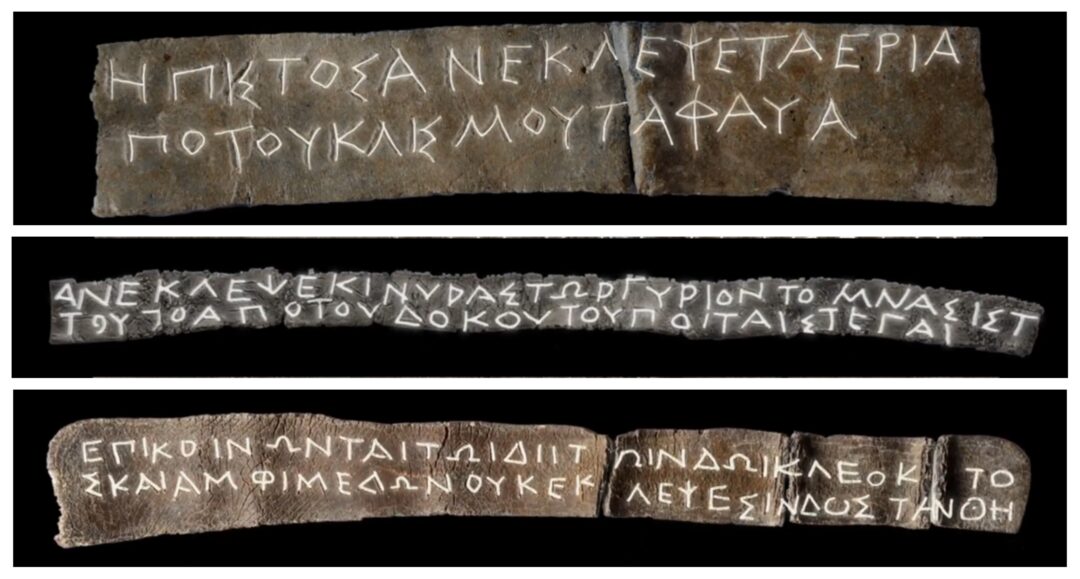
“Was it Pistos that stole the wool from the bed mattress?” (upper), “Did Kyniras steal the money Mnisistratos had hidden in the attic beam?” (middle), “Zeus Dodona, Kleokritos and Amphimedon ask you: did Sindos steal the flowers?” (lower)
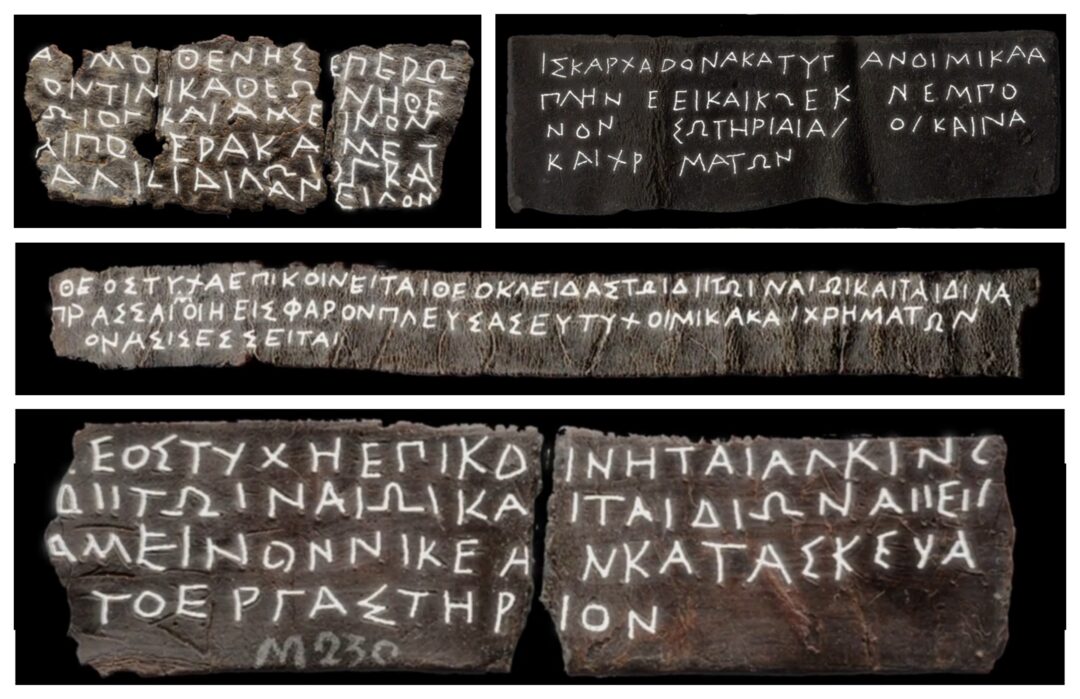
“Zeus Naios and Dione I ask you: would it be in my best interests to migrate to Chalkis?” (upper left), “Will I, the ship and my cargo be safe on the voyage I am making to Carthage?” (upper right), “Zeus Naios and Dione, it’s Theokleides speaking: will I gain money if I go to Pharos?” (middle), “Zeus Naios and Dione, its Alkinoos asking you: will Nikeas be well enough to fit out his workshop?” (lower)
Read also:
The Cultural Route of the Ancient Theatres of Epirus
Archaic Period – Society – Apollonian Oracles and Archaic Period – Society – Oracular Methods
I.A.
TAGS: ANCIENT GREECE | ARCHAEOLOGY | MUSEUMS | ORACLE | TOURISM

